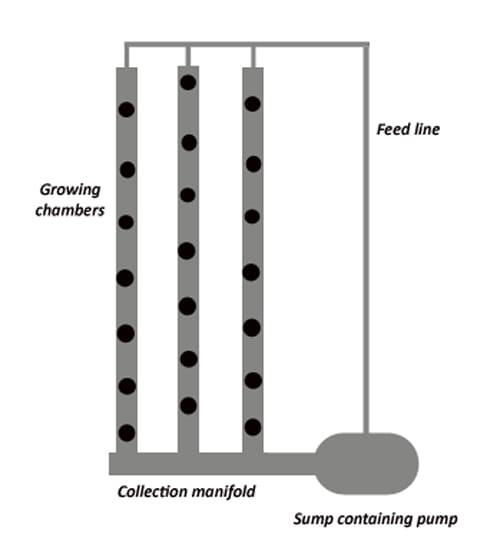I was approached by a missionary on a remote Caribbean island to help design a simple hydroponics setup for growing vegetables. Most foodstuff need to be shipped in, and that makes them costly.
One of the major constraints was that the system needed to conserve water, primarily through limiting evaporation, and another was that it must have low power consumption, due to the need to use solar panels to generate the needed electricity for pumping.
Single-pot semi-hydroponics was a reasonable starting place, but that presented some issues when it came to distribution of nutrient solution to the pots, and collection of the runoff for recirculation. Instead, we opted for the use of a connected series of PVC pipes that acted both as the growing containers, as well as the distribution and collection system.
The “growing chambers” consisted of 6″, thin wall PVC pipe (commonly known as Schedule 20 “crush pipe” in the US, where it is sold for drainage purposes only). With the pipes laid flat on the ground, holes were drilled in the pipe on 12″- to 24″ centers, depending upon the crop to be grown, using a 5″ hole saw.
The “entry end” of the pipes were capped, then drilled to accept tubing for delivery of the nutrient solution. The “exit end” of the pipes were connected via TEES to create a collection manifold. The collection manifold gravity drained into a 55-gallon plastic drum used as a sump. The growing chambers were filled with LECA growing medium.
A 12-volt submersible pump, powered by a car battery that was recharged by a small solar panel, was placed in the sump, and its output was directed into the entry ends of the growing chambers.
The drawing below is a representation of the setup, looking down from above. The black circles represent the holes drilled for insertion of the plants.

The use of LECA as the growing medium results in the even distribution of the nutrient solution throughout the growing chamber due to its superior wicking properties. That permitted the use of a relatively small pump to “trickle” the solution into the chambers, rather than having to flood them periodically.
The enclosed pipe design limited the evaporation to only the growing holes, and once the crops had been planted, even that could be limited by surrounding the base of the plants with plastic sheets to further limit the open area.
In use, we did find that it was difficult to keep a uniform flow into each of the growing chambers, but by adding a simple in-line valve at the entry point, that was easily adjusted and remedied.